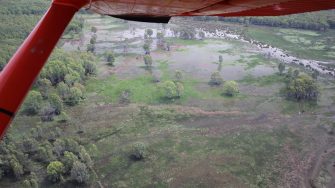
Date: Wednesday, November 4, 2015
Project: Eastern Australian Waterbird Survey
Observer: Richard Kingsford
On our way down the Murray this week – it is always a treat to fly down the river, something I never tire of. It was overcast and drizzly, leaving Sydney. First stop was Albury with no surveying; the skies had cleared here and we had sunny conditions and tail wind. Up here the river winds its way through agricultural land.
The River Murray just downstream of Albury
Hay bales on the edge of the River Murray
Our first survey for the day was Lake Mulwala, the water held back by Yarrawonga Weir which allows water to be diverted down the Mulwala channel for irrigation. The usual fare of waterbirds, a few pelicans, swans and cormorants – the water is not variable enough in its depth which does not encourage the same rich food web found in natural wetlands. Interestingly there is always a small pelican colony here on an island and I saw four reasonably well grown chicks.
Yarrawonga Weir holds the River Murray flow, allowing diversion of water down the largest irrigation channel in the Southern Hemisphere: Mulwala Channel.
We did a short survey of the Murray channel next, just west of the town of Tocumwal. We do five of these at different sections along the river. There are never more than a handful of waterbirds on these sections of the river.
Next, it was river red gum country. We surveyed our two biggest river red gum forests: the Barmah-Millewa and Koondrook-Pericoota Forests. Both involved first flying down the main channel which only has a few cormorants. The Barmah-Millewa Forest also has areas of open water, Barmah Lake and Moira Lake and a few reedbed swamps.
Swamps in Barmah-Millewa Forest where there were small colonies of Australian white ibis, a few straw-necked ibis and royal spoonbills.
Surveying the Barmah-Millewa Forest and its swamps.
Small colonies of Australian white ibis, with a few straw-necked ibis were scattered throughout the swamps in the Barmah-Millewa Forest.
Surveying Moira Lake in the Barmah-Millewa Forest.
We then surveyed the Koondrook-Pericoota river red gum forest. Here water was primarily confined to the main channel and saw few birds. This is one of the areas where there is a heavy investment in engineering channels which can take environmental water from the river out onto the floodplains.
Regulators and channel designed to take environmental flows from the River Murray out on to the floodplains of the Koondrook-Pericoota Forest.
Finally we ended the day surveying Hattah Lakes, many of which had water from environmental flows. There was a great contrast between some lakes which were full and others that were drying back. The shallow and drying lakes had many hundreds of different species of waterbirds while the ‘full’ lakes primarily provided habitat for the fish eating birds, such as pelicans and cormorants.
Surveying the Hattah Lakes, supplied by environmental water
The relatively small Hattah Lakes provide important habitat for many waterbirds during dry period when there is shallow habitat created.
